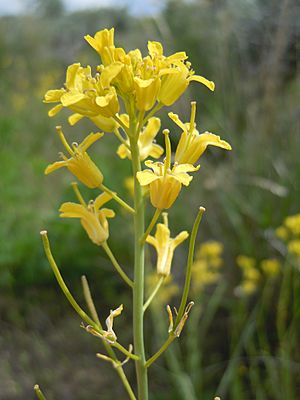Flaxleaf plainsmustard facts for kids
Quick facts for kids Flaxleaf plainsmustard |
|
|---|---|
 |
|
| Conservation status | |
| Scientific classification | |
| Kingdom: | |
| (unranked): | |
| (unranked): | |
| (unranked): | |
| Order: | |
| Family: | |
| Genus: |
Schoenocrambe
|
| Species: |
S. linifolia
|
| Binomial name | |
| Schoenocrambe linifolia (Nutt.) Greene
|
|
| Synonyms | |
|
Sisymbrium linifolium Nutt. |
|
Schoenocrambe linifolia is a type of flowering plant. It belongs to the mustard family. People often call it flaxleaf plainsmustard or skeleton mustard. This plant grows naturally in western North America. You can find it from British Columbia in Canada all the way south to Arizona in the United States. It's very common, especially in areas like the Columbia, Great, and Colorado Basins.
Contents
What is Schoenocrambe linifolia?
This plant is a perennial. This means it lives for more than two years. It grows straight stems that can reach about half a meter (about 20 inches) tall. The plant has a special underground stem called a rhizome. This rhizome is long and deep.
The leaves of the plant are long and narrow. Sometimes, the leaves near the bottom of the plant are divided. The fruit of the plant is a thin pod. This pod is called a silique and can be up to 6 centimeters (about 2.4 inches) long.
How This Plant Grows and Recovers
Schoenocrambe linifolia can grow in two ways. It can grow from its seeds. It can also sprout new plants from its rhizome and a part called the caudex. The caudex is a woody base of the plant.
This ability to resprout is very helpful. It allows the plant to recover quickly after a wildfire. Even if the top part of the plant burns, the underground parts can grow new stems and leaves.
Where Schoenocrambe linifolia Lives
You can find this plant in many different places. It grows in areas with salt-desert shrubs. It also lives in sagebrush areas. You might see it in pinyon-juniper woodlands. It also grows in mountain shrub areas.
This plant is common where Ponderosa pine trees grow. It also likes areas with trembling aspen trees (Populus tremuloides). In some regions, it's the most common forb. A forb is a plant that is not a grass, sedge, or rush. For example, it's common in northeastern Utah and the Snake River Plain grasslands.
Uses for People
The leaves of Schoenocrambe linifolia have a spicy taste. They are spicy enough to be used like wasabi. You can also mix them into salads. They are good in other dishes too.


